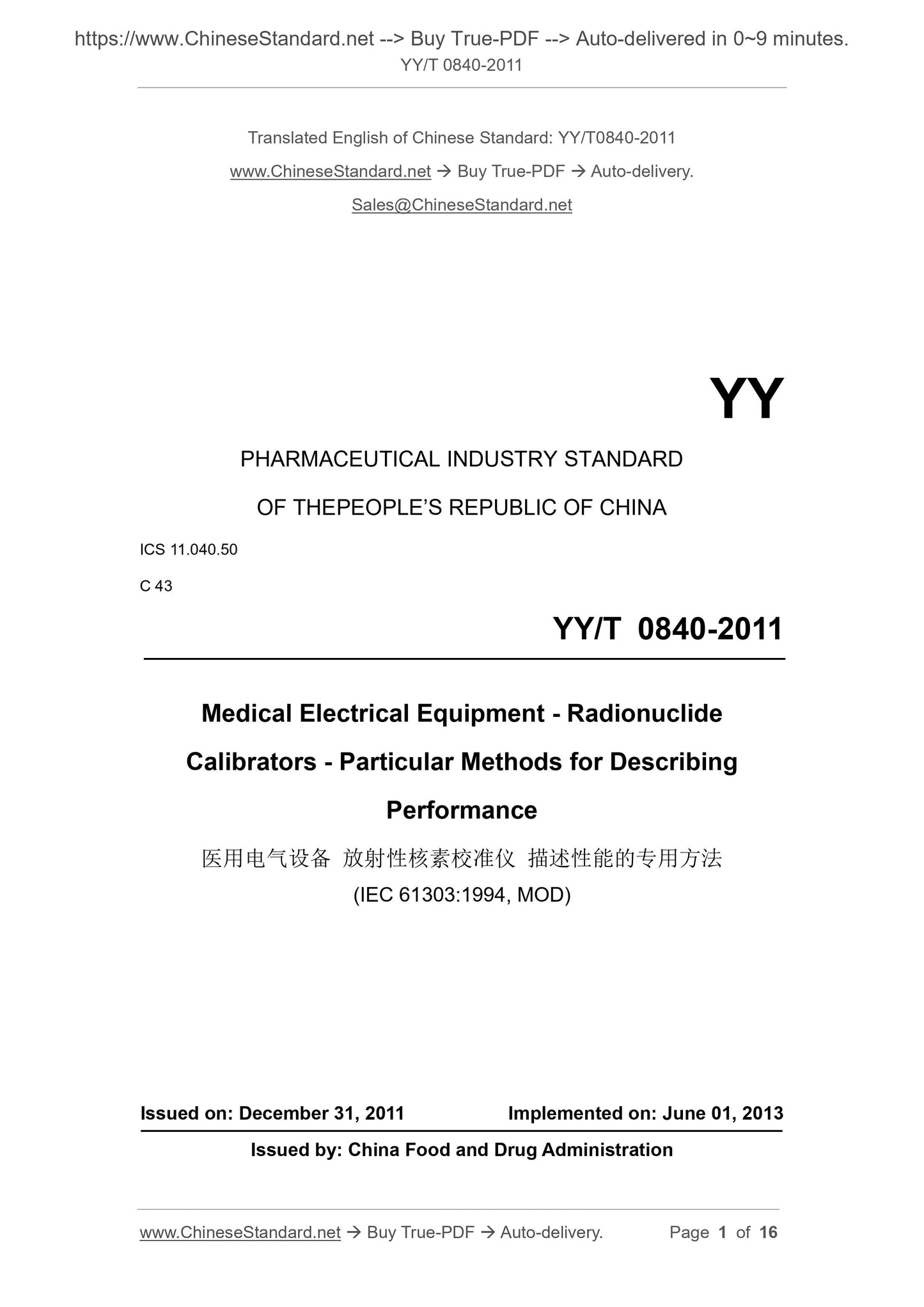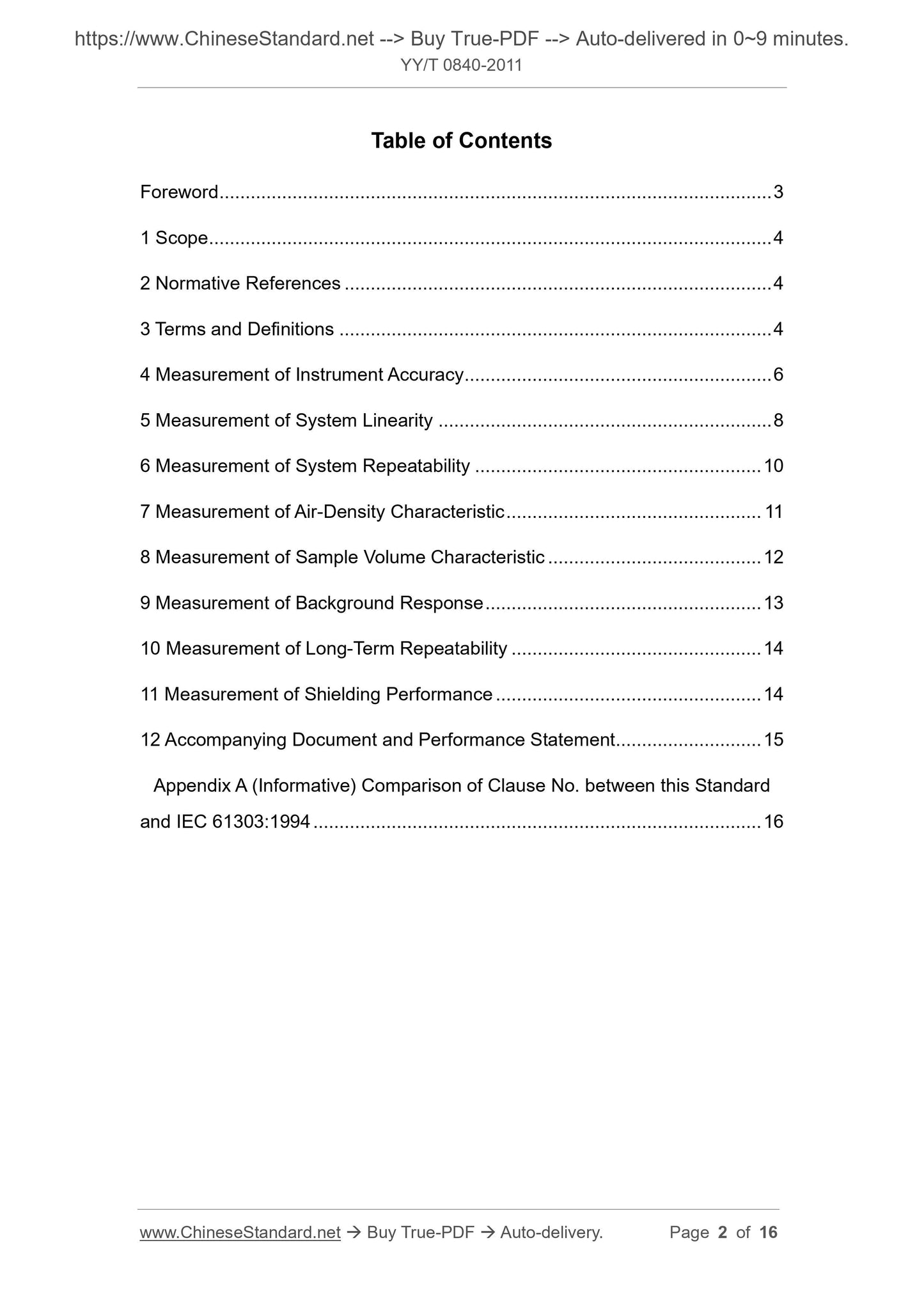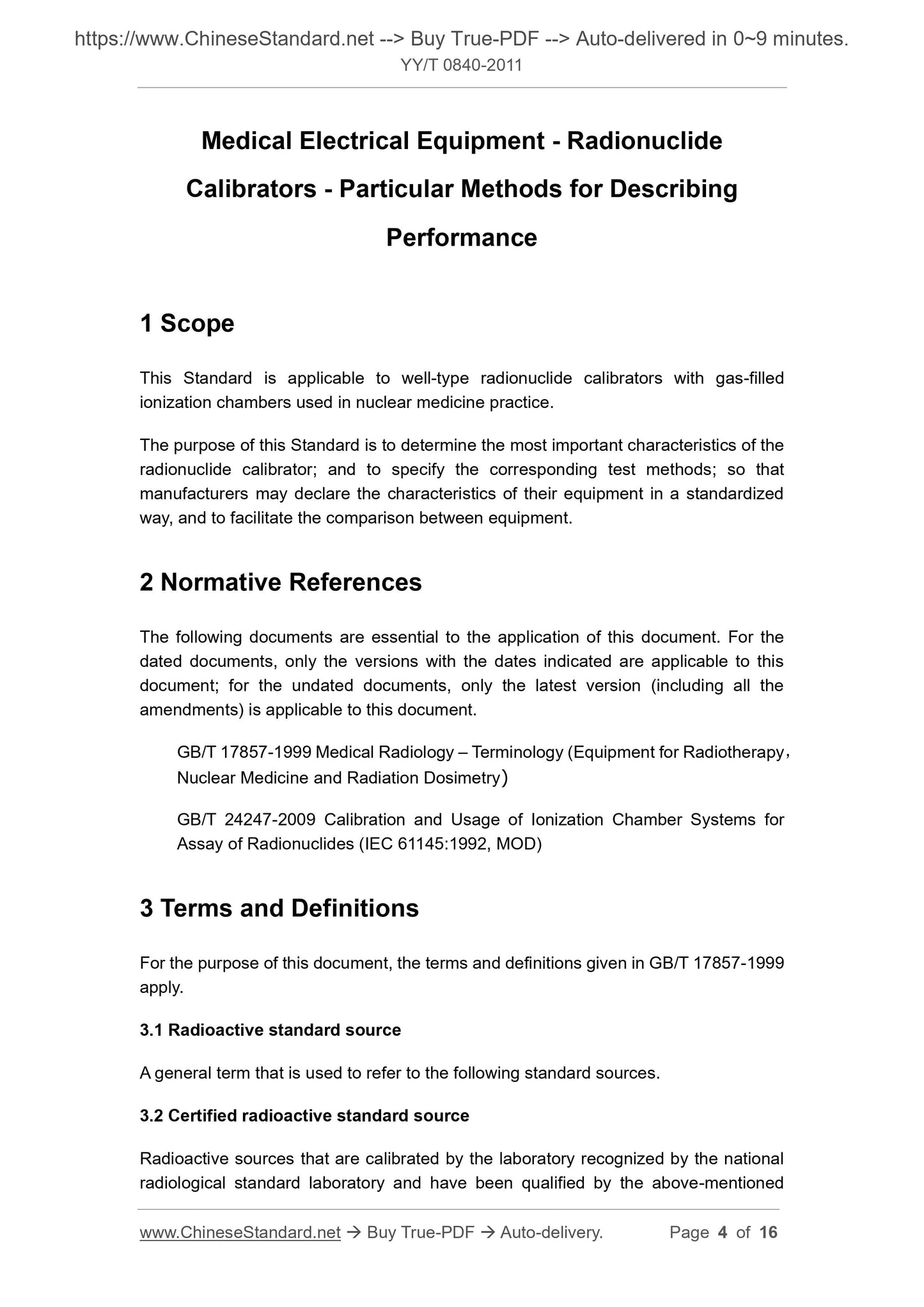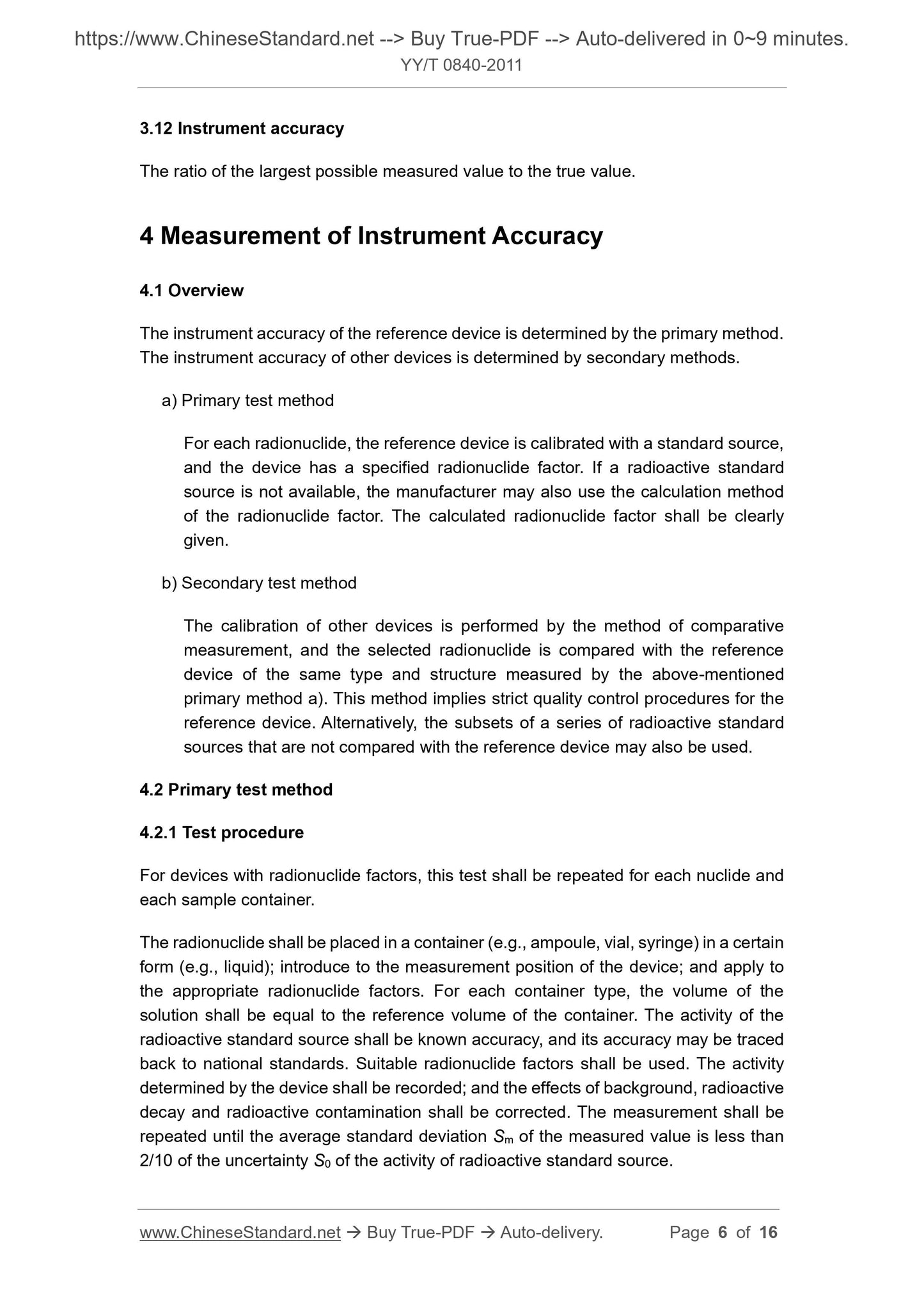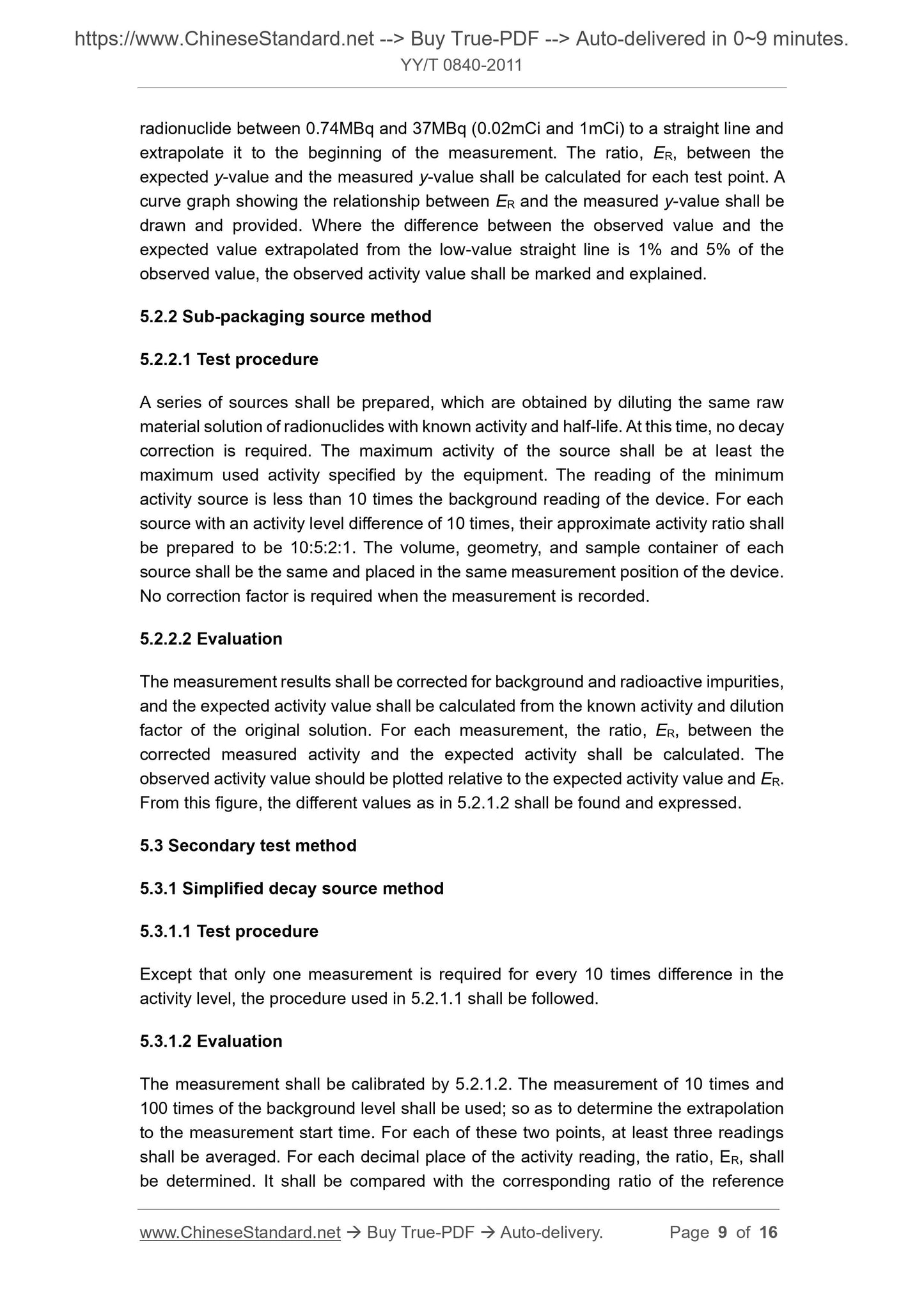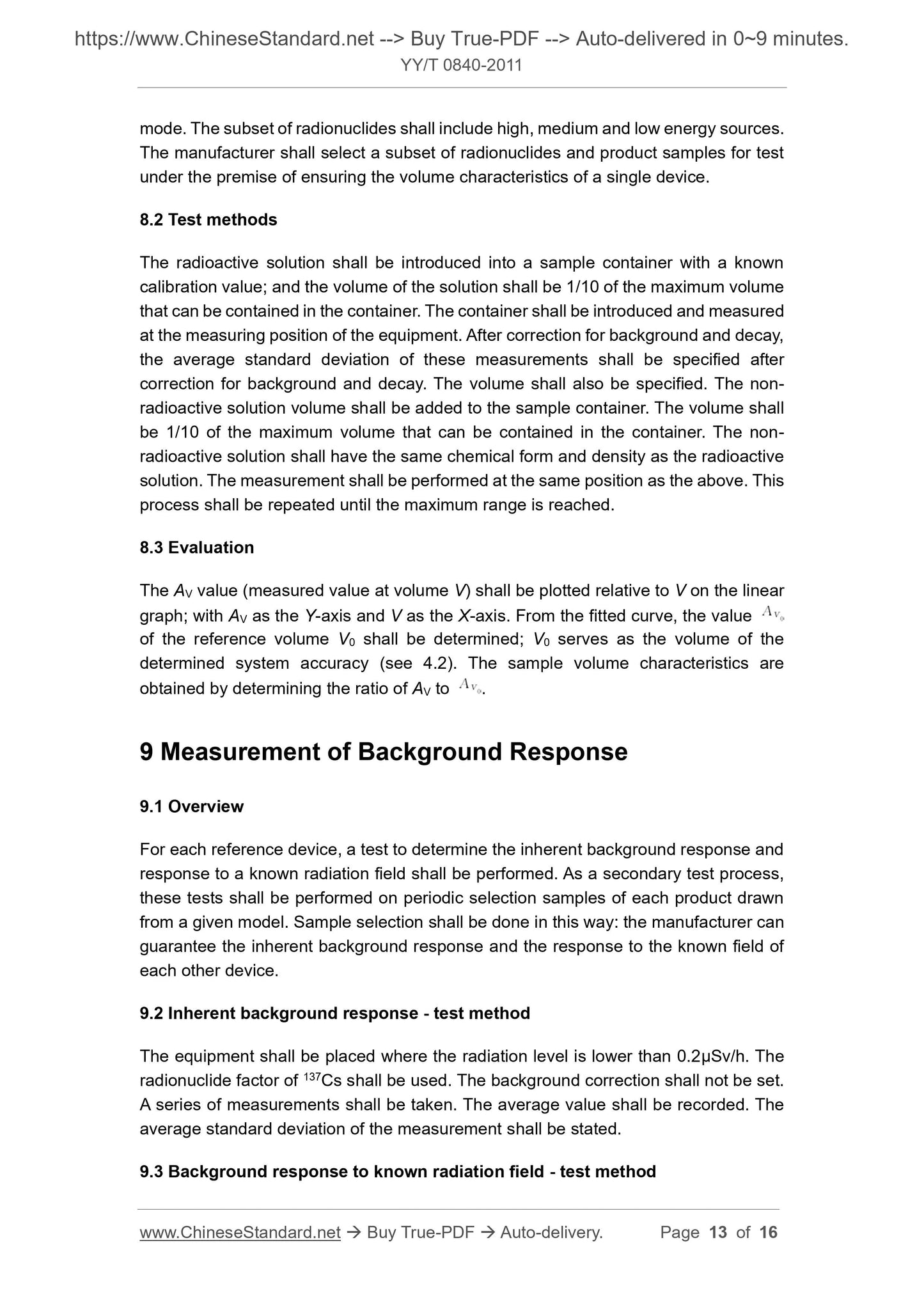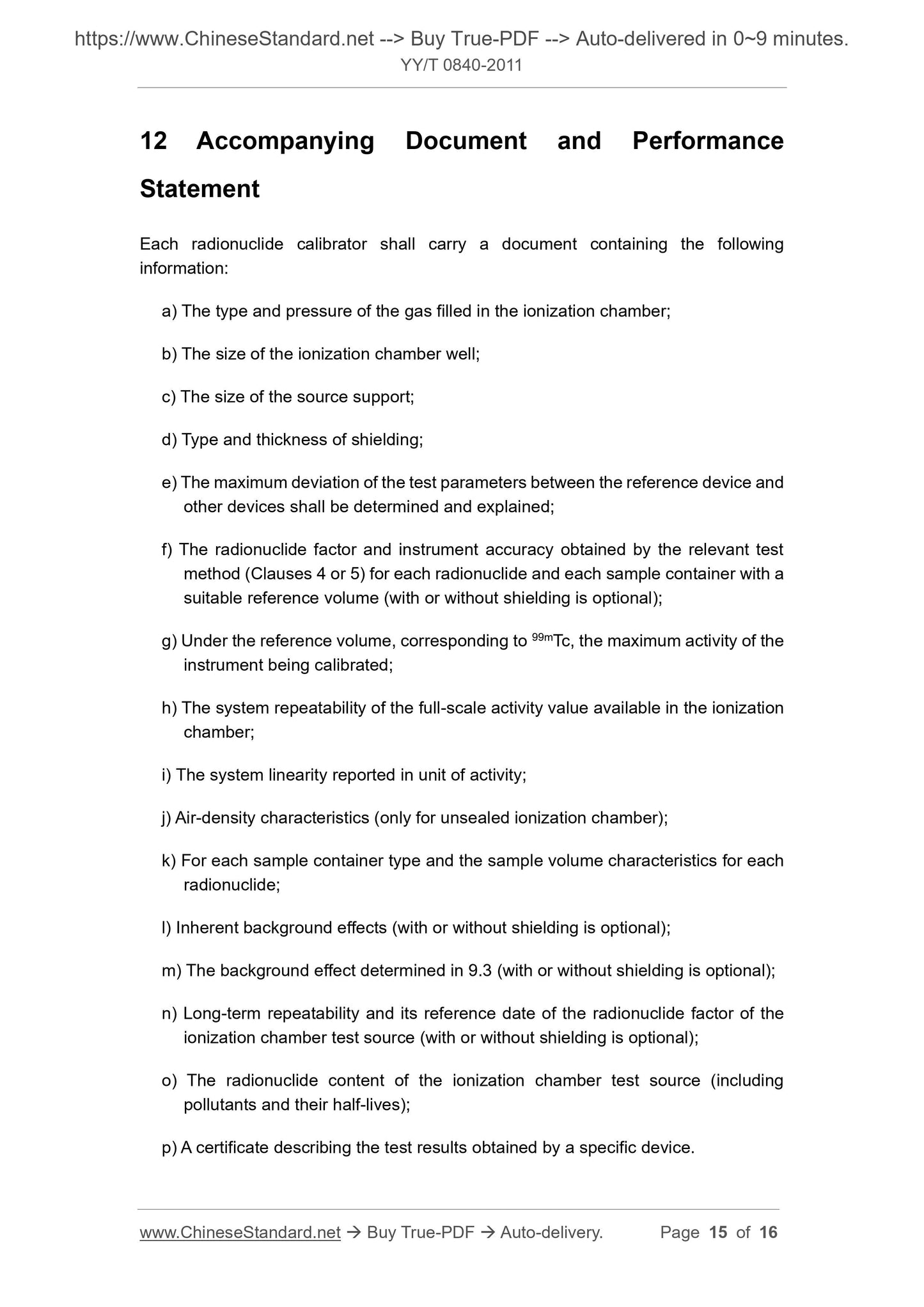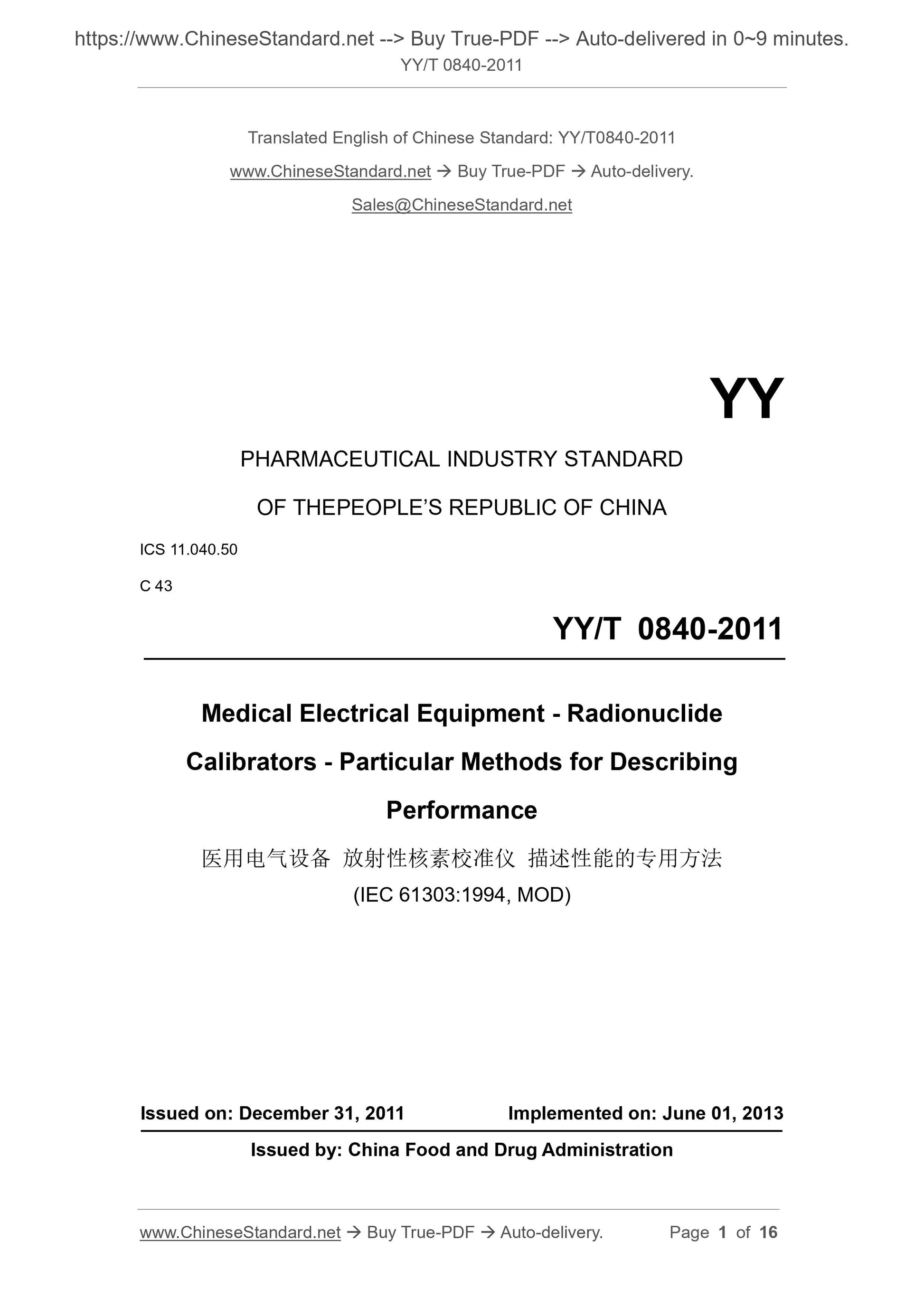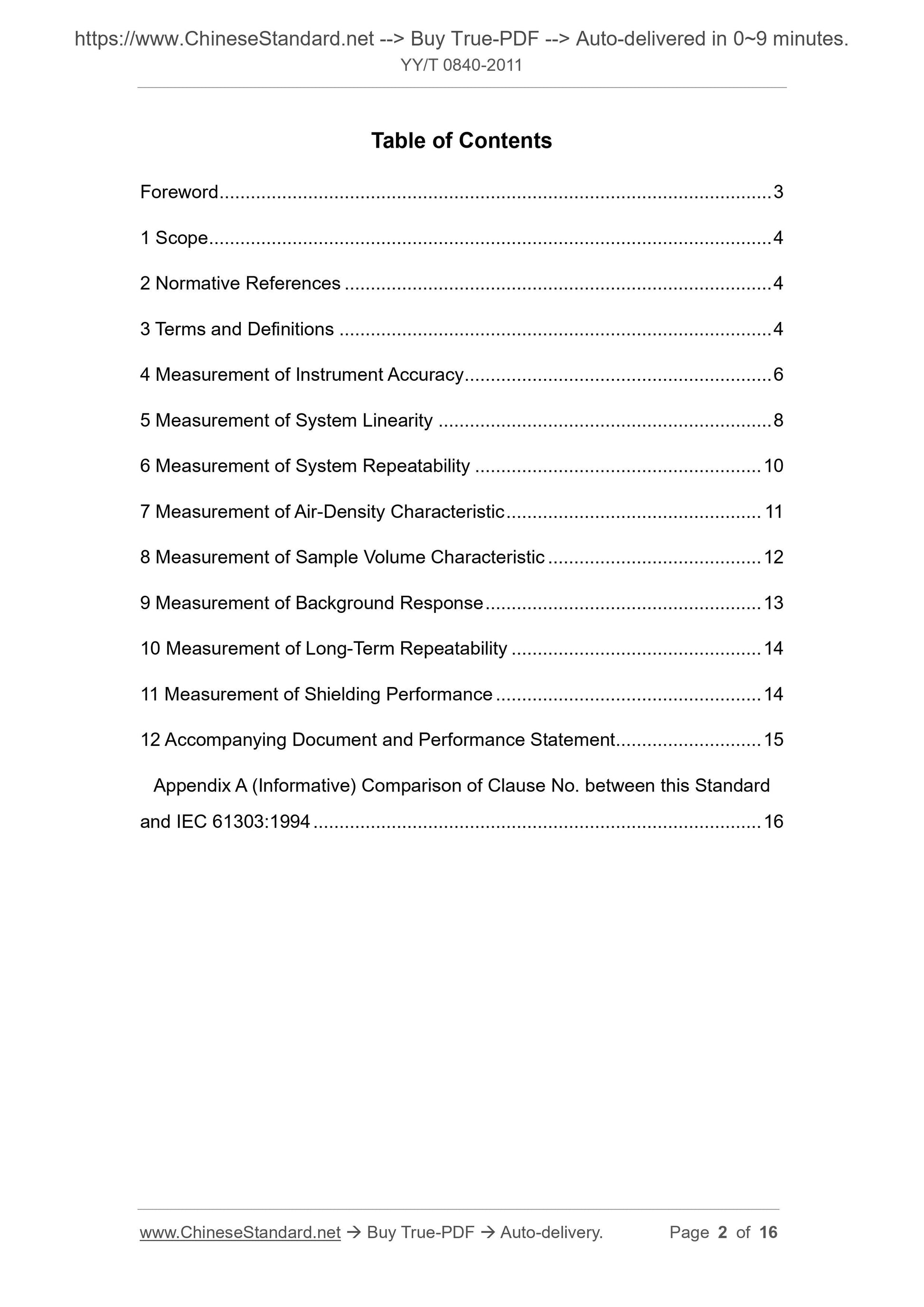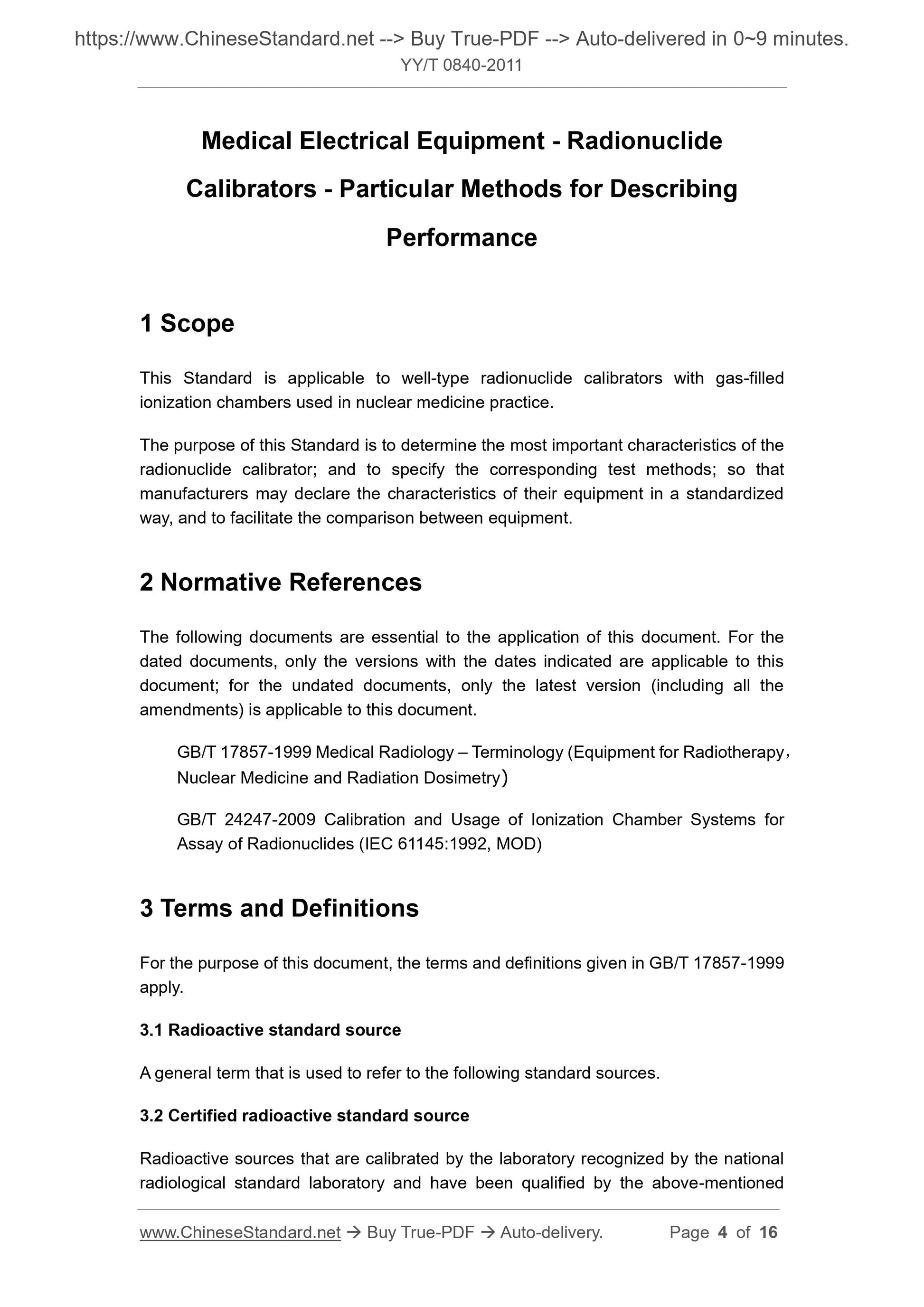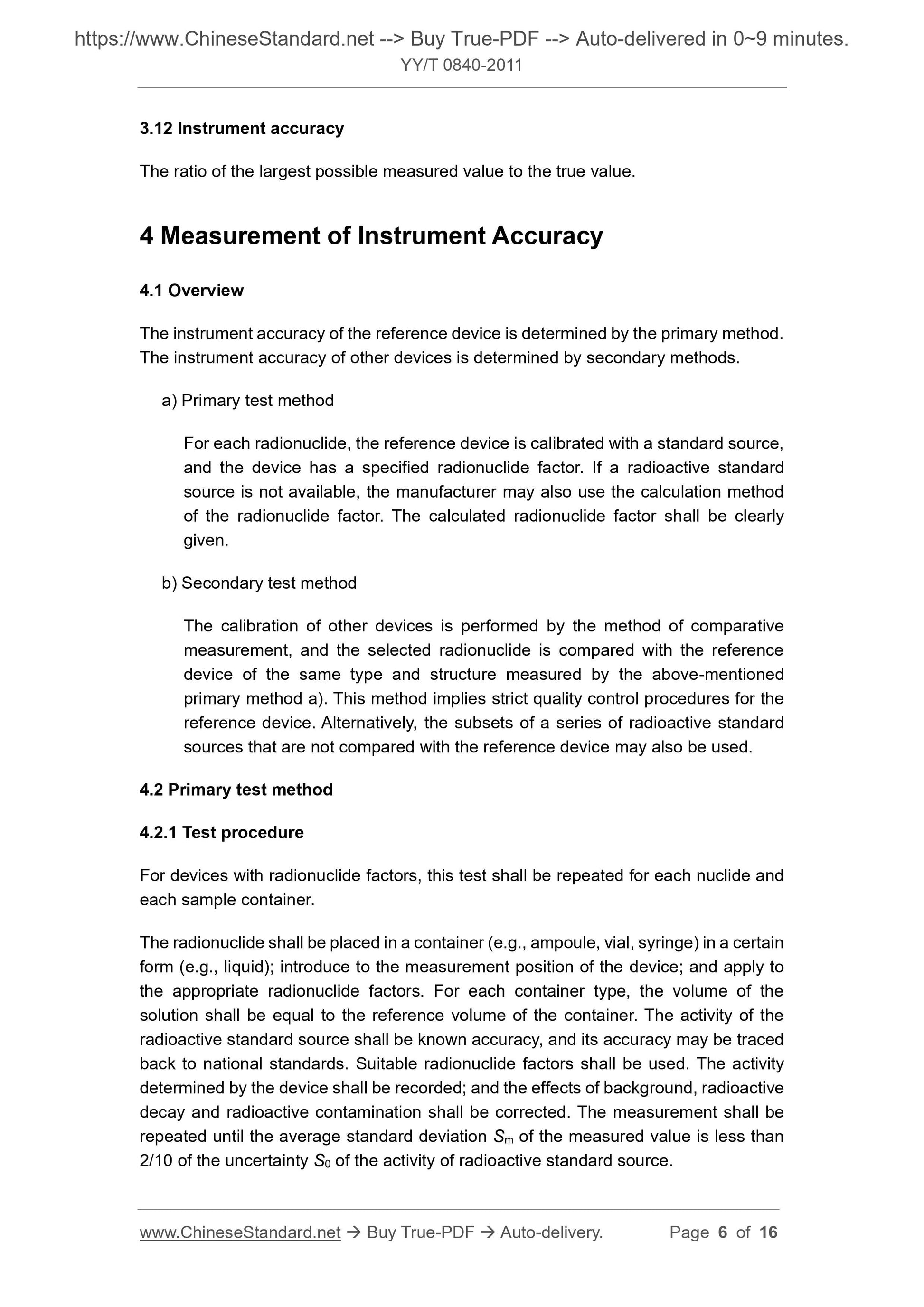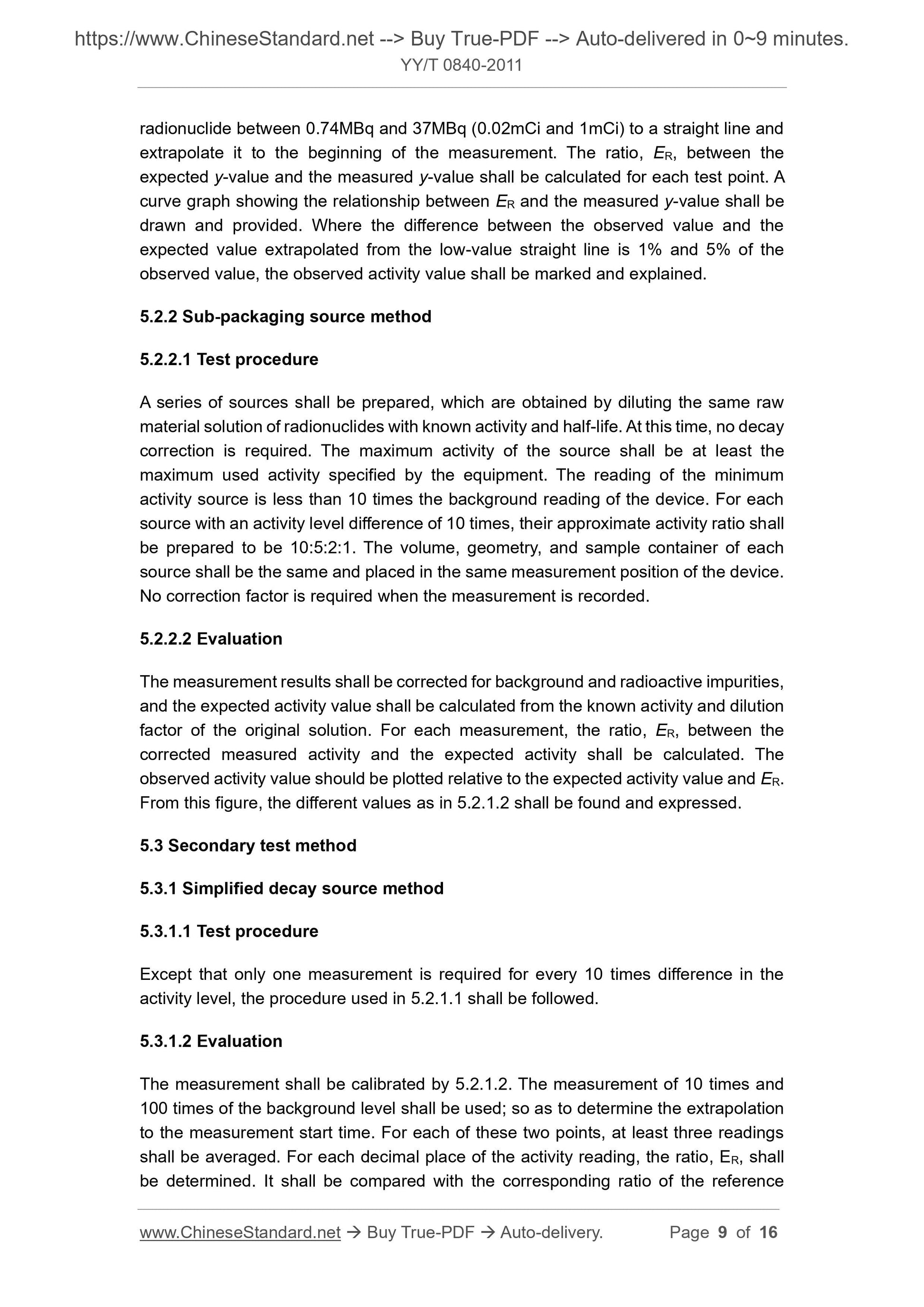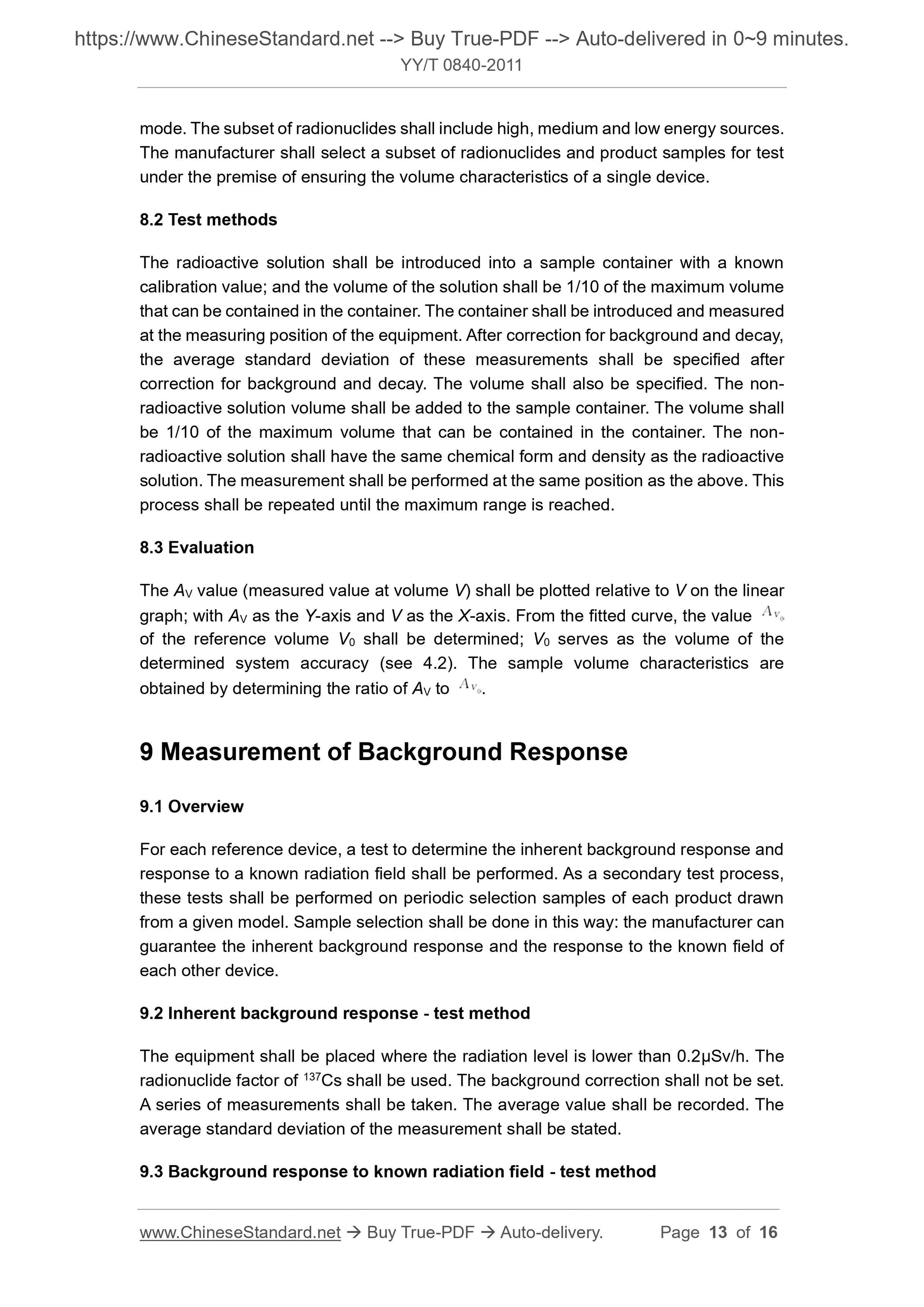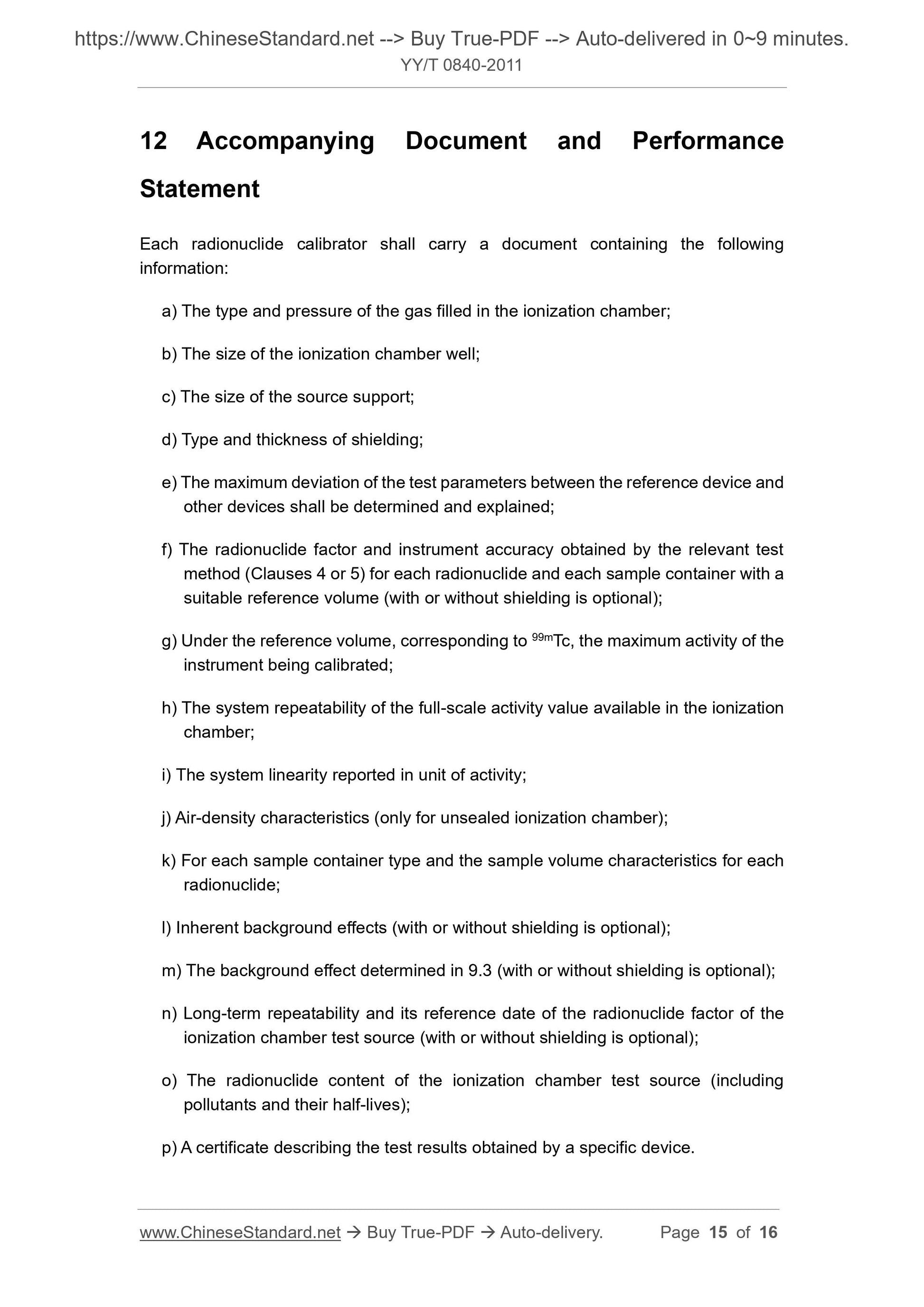1
/
de
7
PayPal, credit cards. Download editable-PDF & invoice in 1 second!
YY/T 0840-2011 English PDF (YYT0840-2011)
YY/T 0840-2011 English PDF (YYT0840-2011)
Prix habituel
$220.00 USD
Prix habituel
Prix promotionnel
$220.00 USD
Prix unitaire
/
par
Frais d'expédition calculés à l'étape de paiement.
Impossible de charger la disponibilité du service de retrait
Delivery: 3 seconds. Download true-PDF + Invoice.
Get QUOTATION in 1-minute: Click YY/T 0840-2011
Historical versions: YY/T 0840-2011
Preview True-PDF (Reload/Scroll if blank)
YY/T 0840-2011: Medical electrical equipment. Radionuclide calibrators. Particular methods for describing performance
YY/T 0840-2011
YY
PHARMACEUTICAL INDUSTRY STANDARD
OF THEPEOPLE’S REPUBLIC OF CHINA
ICS 11.040.50
C 43
Medical Electrical Equipment - Radionuclide
Calibrators - Particular Methods for Describing
Performance
(IEC 61303:1994, MOD)
ISSUED ON: DECEMBER 31, 2011
IMPLEMENTED ON: JUNE 01, 2013
Issued by: China Food and Drug Administration
Table of Contents
Foreword ... 3
1 Scope ... 4
2 Normative References ... 4
3 Terms and Definitions ... 4
4 Measurement of Instrument Accuracy ... 6
5 Measurement of System Linearity ... 8
6 Measurement of System Repeatability ... 10
7 Measurement of Air-Density Characteristic ... 11
8 Measurement of Sample Volume Characteristic ... 12
9 Measurement of Background Response ... 13
10 Measurement of Long-Term Repeatability ... 14
11 Measurement of Shielding Performance ... 14
12 Accompanying Document and Performance Statement... 15
Appendix A (Informative) Comparison of Clause No. between this Standard
and IEC 61303:1994 ... 16
Medical Electrical Equipment - Radionuclide
Calibrators - Particular Methods for Describing
Performance
1 Scope
This Standard is applicable to well-type radionuclide calibrators with gas-filled
ionization chambers used in nuclear medicine practice.
The purpose of this Standard is to determine the most important characteristics of the
radionuclide calibrator; and to specify the corresponding test methods; so that
manufacturers may declare the characteristics of their equipment in a standardized
way, and to facilitate the comparison between equipment.
2 Normative References
The following documents are essential to the application of this document. For the
dated documents, only the versions with the dates indicated are applicable to this
document; for the undated documents, only the latest version (including all the
amendments) is applicable to this document.
GB/T 17857-1999 Medical Radiology – Terminology (Equipment for Radiotherapy,
Nuclear Medicine and Radiation Dosimetry)
GB/T 24247-2009 Calibration and Usage of Ionization Chamber Systems for
Assay of Radionuclides (IEC 61145:1992, MOD)
3 Terms and Definitions
For the purpose of this document, the terms and definitions given in GB/T 17857-1999
apply.
3.1 Radioactive standard source
A general term that is used to refer to the following standard sources.
3.2 Certified radioactive standard source
Radioactive sources that are calibrated by the laboratory recognized by the national
radiological standard laboratory and have been qualified by the above-mentioned
3.12 Instrument accuracy
The ratio of the largest possible measured value to the true value.
4 Measurement of Instrument Accuracy
4.1 Overview
The instrument accuracy of the reference device is determined by the primary method.
The instrument accuracy of other devices is determined by secondary methods.
a) Primary test method
For each radionuclide, the reference device is calibrated with a standard source,
and the device has a specified radionuclide factor. If a radioactive standard
source is not available, the manufacturer may also use the calculation method
of the radionuclide factor. The calculated radionuclide factor shall be clearly
given.
b) Secondary test method
The calibration of other devices is performed by the method of comparative
measurement, and the selected radionuclide is compared with the reference
device of the same type and structure measured by the above-mentioned
primary method a). This method implies strict quality control procedures for the
reference device. Alternatively, the subsets of a series of radioactive standard
sources that are not compared with the reference device may also be used.
4.2 Primary test method
4.2.1 Test procedure
For devices with radionuclide factors, this test shall be repeated for each nuclide and
each sample container.
The radionuclide shall be placed in a container (e.g., ampoule, vial, syringe) in a certain
form (e.g., liquid); introduce to the measurement position of the device; and apply to
the appropriate radionuclide factors. For each container type, the volume of the
solution shall be equal to the reference volume of the container. The activity of the
radioactive standard source shall be known accuracy, and its accuracy may be traced
back to national standards. Suitable radionuclide factors shall be used. The activity
determined by the device shall be recorded; and the effects of background, radioactive
decay and radioactive contamination shall be corrected. The measurement shall be
repeated until the average standard deviation Sm of the measured value is less than
2/10 of the uncertainty S0 of the activity of radioactive standard source.
radionuclide between 0.74MBq and 37MBq (0.02mCi and 1mCi) to a straight line and
extrapolate it to the beginning of the measurement. The ratio, ER, between the
expected y-value and the measured y-value shall be calculated for each test point. A
curve graph showing the relationship between ER and the measured y-value shall be
drawn and provided. Where the difference between the observed value and the
expected value extrapolated from the low-value straight line is 1% and 5% of the
observed value, the observed activity value shall be marked and explained.
5.2.2 Sub-packaging source method
5.2.2.1 Test procedure
A series of sources shall be prepared, which are obtained by diluting the same raw
material solution of radionuclides with known activity and half-life. At this time, no decay
correction is required. The maximum activity of the source shall be at least the
maximum used activity specified by the equipment. The reading of the minimum
activity source is less than 10 times the background reading of the device. For each
source with an activity level difference of 10 times, their approximate activity ratio shall
be prepared to be 10:5:2:1. The volume, geometry, and sample container of each
source shall be the same and placed in the same measurement position of the device.
No correction factor is required when the measurement is recorded.
5.2.2.2 Evaluation
The measurement results shall be corrected for background and radioactive impurities,
and the expected activity value shall be calculated from the known activity and dilution
factor of the original solution. For each measurement, the ratio, ER, between the
corrected measured activity and the expected activity shall be calculated. The
observed activity value should be plotted relative to the expected activity value and ER.
From this figure, the different values as in 5.2.1.2 shall be found and expressed.
5.3 Secondary test method
5.3.1 Simplified decay source method
5.3.1.1 Test procedure
Except that only one measurement is required for every 10 times difference in the
activity level, the procedure used in 5.2.1.1 shall be followed.
5.3.1.2 Evaluation
The measurement shall be calibrated by 5.2.1.2. The measurement of 10 times and
100 times of the background level shall be used; so as to determine the extrapolation
to the measurement start time. For each of these two points, at least three readings
shall be averaged. For each decimal place of the activity reading, the ratio, ER, shall
be determined. It shall be compared with the corresponding ratio of the reference
mode. The subset of radionuclides shall include high, medium and low energy sources.
The manufacturer shall select a subset of radionuclides and product samples for test
under...
Get QUOTATION in 1-minute: Click YY/T 0840-2011
Historical versions: YY/T 0840-2011
Preview True-PDF (Reload/Scroll if blank)
YY/T 0840-2011: Medical electrical equipment. Radionuclide calibrators. Particular methods for describing performance
YY/T 0840-2011
YY
PHARMACEUTICAL INDUSTRY STANDARD
OF THEPEOPLE’S REPUBLIC OF CHINA
ICS 11.040.50
C 43
Medical Electrical Equipment - Radionuclide
Calibrators - Particular Methods for Describing
Performance
(IEC 61303:1994, MOD)
ISSUED ON: DECEMBER 31, 2011
IMPLEMENTED ON: JUNE 01, 2013
Issued by: China Food and Drug Administration
Table of Contents
Foreword ... 3
1 Scope ... 4
2 Normative References ... 4
3 Terms and Definitions ... 4
4 Measurement of Instrument Accuracy ... 6
5 Measurement of System Linearity ... 8
6 Measurement of System Repeatability ... 10
7 Measurement of Air-Density Characteristic ... 11
8 Measurement of Sample Volume Characteristic ... 12
9 Measurement of Background Response ... 13
10 Measurement of Long-Term Repeatability ... 14
11 Measurement of Shielding Performance ... 14
12 Accompanying Document and Performance Statement... 15
Appendix A (Informative) Comparison of Clause No. between this Standard
and IEC 61303:1994 ... 16
Medical Electrical Equipment - Radionuclide
Calibrators - Particular Methods for Describing
Performance
1 Scope
This Standard is applicable to well-type radionuclide calibrators with gas-filled
ionization chambers used in nuclear medicine practice.
The purpose of this Standard is to determine the most important characteristics of the
radionuclide calibrator; and to specify the corresponding test methods; so that
manufacturers may declare the characteristics of their equipment in a standardized
way, and to facilitate the comparison between equipment.
2 Normative References
The following documents are essential to the application of this document. For the
dated documents, only the versions with the dates indicated are applicable to this
document; for the undated documents, only the latest version (including all the
amendments) is applicable to this document.
GB/T 17857-1999 Medical Radiology – Terminology (Equipment for Radiotherapy,
Nuclear Medicine and Radiation Dosimetry)
GB/T 24247-2009 Calibration and Usage of Ionization Chamber Systems for
Assay of Radionuclides (IEC 61145:1992, MOD)
3 Terms and Definitions
For the purpose of this document, the terms and definitions given in GB/T 17857-1999
apply.
3.1 Radioactive standard source
A general term that is used to refer to the following standard sources.
3.2 Certified radioactive standard source
Radioactive sources that are calibrated by the laboratory recognized by the national
radiological standard laboratory and have been qualified by the above-mentioned
3.12 Instrument accuracy
The ratio of the largest possible measured value to the true value.
4 Measurement of Instrument Accuracy
4.1 Overview
The instrument accuracy of the reference device is determined by the primary method.
The instrument accuracy of other devices is determined by secondary methods.
a) Primary test method
For each radionuclide, the reference device is calibrated with a standard source,
and the device has a specified radionuclide factor. If a radioactive standard
source is not available, the manufacturer may also use the calculation method
of the radionuclide factor. The calculated radionuclide factor shall be clearly
given.
b) Secondary test method
The calibration of other devices is performed by the method of comparative
measurement, and the selected radionuclide is compared with the reference
device of the same type and structure measured by the above-mentioned
primary method a). This method implies strict quality control procedures for the
reference device. Alternatively, the subsets of a series of radioactive standard
sources that are not compared with the reference device may also be used.
4.2 Primary test method
4.2.1 Test procedure
For devices with radionuclide factors, this test shall be repeated for each nuclide and
each sample container.
The radionuclide shall be placed in a container (e.g., ampoule, vial, syringe) in a certain
form (e.g., liquid); introduce to the measurement position of the device; and apply to
the appropriate radionuclide factors. For each container type, the volume of the
solution shall be equal to the reference volume of the container. The activity of the
radioactive standard source shall be known accuracy, and its accuracy may be traced
back to national standards. Suitable radionuclide factors shall be used. The activity
determined by the device shall be recorded; and the effects of background, radioactive
decay and radioactive contamination shall be corrected. The measurement shall be
repeated until the average standard deviation Sm of the measured value is less than
2/10 of the uncertainty S0 of the activity of radioactive standard source.
radionuclide between 0.74MBq and 37MBq (0.02mCi and 1mCi) to a straight line and
extrapolate it to the beginning of the measurement. The ratio, ER, between the
expected y-value and the measured y-value shall be calculated for each test point. A
curve graph showing the relationship between ER and the measured y-value shall be
drawn and provided. Where the difference between the observed value and the
expected value extrapolated from the low-value straight line is 1% and 5% of the
observed value, the observed activity value shall be marked and explained.
5.2.2 Sub-packaging source method
5.2.2.1 Test procedure
A series of sources shall be prepared, which are obtained by diluting the same raw
material solution of radionuclides with known activity and half-life. At this time, no decay
correction is required. The maximum activity of the source shall be at least the
maximum used activity specified by the equipment. The reading of the minimum
activity source is less than 10 times the background reading of the device. For each
source with an activity level difference of 10 times, their approximate activity ratio shall
be prepared to be 10:5:2:1. The volume, geometry, and sample container of each
source shall be the same and placed in the same measurement position of the device.
No correction factor is required when the measurement is recorded.
5.2.2.2 Evaluation
The measurement results shall be corrected for background and radioactive impurities,
and the expected activity value shall be calculated from the known activity and dilution
factor of the original solution. For each measurement, the ratio, ER, between the
corrected measured activity and the expected activity shall be calculated. The
observed activity value should be plotted relative to the expected activity value and ER.
From this figure, the different values as in 5.2.1.2 shall be found and expressed.
5.3 Secondary test method
5.3.1 Simplified decay source method
5.3.1.1 Test procedure
Except that only one measurement is required for every 10 times difference in the
activity level, the procedure used in 5.2.1.1 shall be followed.
5.3.1.2 Evaluation
The measurement shall be calibrated by 5.2.1.2. The measurement of 10 times and
100 times of the background level shall be used; so as to determine the extrapolation
to the measurement start time. For each of these two points, at least three readings
shall be averaged. For each decimal place of the activity reading, the ratio, ER, shall
be determined. It shall be compared with the corresponding ratio of the reference
mode. The subset of radionuclides shall include high, medium and low energy sources.
The manufacturer shall select a subset of radionuclides and product samples for test
under...
Share
